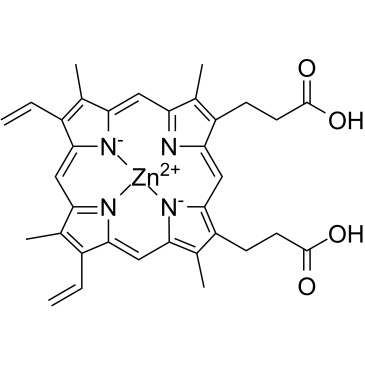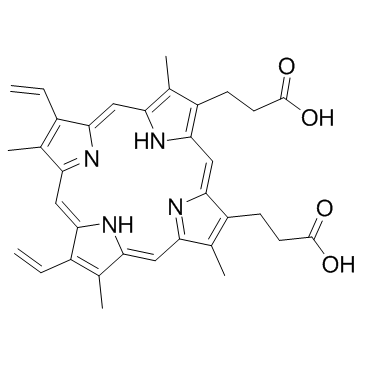Zinc protoporphyrin

Zinc protoporphyrin structure
|
Common Name | Zinc protoporphyrin | ||
|---|---|---|---|---|
| CAS Number | 15442-64-5 | Molecular Weight | 626.051 | |
| Density | N/A | Boiling Point | 1128.5ºC at 760mmHg | |
| Molecular Formula | C34H32N4O4Zn | Melting Point | N/A | |
| MSDS | Chinese USA | Flash Point | 636.3ºC | |
Use of Zinc protoporphyrinZinc Protoporphyrin (Zn(II)-protoporphyrin IX) is a competitive heme oxygenase-1 (HO-1) inhibitor, markedly attenuates the protective effects of Phloroglucinol (PG) against H2O2[1]. Zinc Protoporphyrin is a normal metabolite formed in trace amounts during heme biosynthesis and used as a screening marker of iron deficiency in individual pregnant women and children, but also to assess population iron status in combination with haemoglobin concentration[2]. |
| Name | zinc protoporphyrin |
|---|---|
| Synonym | More Synonyms |
| Description | Zinc Protoporphyrin (Zn(II)-protoporphyrin IX) is a competitive heme oxygenase-1 (HO-1) inhibitor, markedly attenuates the protective effects of Phloroglucinol (PG) against H2O2[1]. Zinc Protoporphyrin is a normal metabolite formed in trace amounts during heme biosynthesis and used as a screening marker of iron deficiency in individual pregnant women and children, but also to assess population iron status in combination with haemoglobin concentration[2]. |
|---|---|
| Related Catalog | |
| References |
| Boiling Point | 1128.5ºC at 760mmHg |
|---|---|
| Molecular Formula | C34H32N4O4Zn |
| Molecular Weight | 626.051 |
| Flash Point | 636.3ºC |
| Exact Mass | 624.171509 |
| PSA | 109.18000 |
| LogP | 3.60970 |
| Vapour Pressure | 0mmHg at 25°C |
|
Section 1: Product Identification Chemical Name:Zinc protoporphyrin CAS Registry Number:15442-64-5 Formula:(C34H32N4O4)Zn EINECS Number:239-455-7 Chemical Family:metal porphine (porphyrin) complex Synonym:protoporphoryn zinc chelate
Section 2: Composition and Information on Ingredients IngredientCAS NumberPercentACGIH (TWA)OSHA (PEL) Title Compound15442-64-5100%no datano data Section 3: Hazards Identification Emergency Overview:Dust may be irritating to skin, eyes and mucous membranes. May be harmful if swallowed. Primary Routes of Exposure:Ingestion, inhalation Eye Contact:May cause slight to mild irritation of the eyes. Skin Contact:May cause slight to mild irritation of the skin. Inhalation:Some zinc containing dusts irritate the respiratory system and cause metallic taste, dry throat, and chills. Ingestion:If solubilized, Zinc compounds give a harsh metallic taste and may cause nausea and vomiting. Acute Health Affects:May be irritating to skin, eyes and respiratory tract. Inhalation may cause chills and nausea. No serious long-term chronic effects associated with zinc compounds. Prolonged inhalation may cause Chronic Health Affects: laryngitis. Prolonged ingestion may cause constipation. NTP:No IARC:No OSHA:No SECTION 4: First Aid Measures Immediately flush the eyes with copious amounts of water for at least 10-15 minutes. A victim may need Eye Exposure: assistance in keeping their eye lids open. Get immediate medical attention. Wash the affected area with water. Remove contaminated clothes if necessary. Seek medical assistance if Skin Exposure: irritation persists. Remove the victim to fresh air. Closely monitor the victim for signs of respiratory problems, such as difficulty Inhalation: in breathing, coughing, wheezing, or pain. In such cases seek immediate medical assistance. Seek medical attention immediately. Keep the victim calm. Give the victim water (only if conscious). Induce Ingestion: vomiting only if directed by medical personnel. SECTION 5: Fire Fighting Measures Flash Point:not applicable Autoignition Temperature:none Explosion Limits:none Extinguishing Medium:carbon dioxide, foam or dry powder If this product is involved in a fire, fire fighters should be equipped with a NIOSH approved positive pressure Special Fire Fighting Procedures: self- contained breathing apparatus and full protective clothing. Hazardous Combustion andIf involved in a fire this material may emit toxic and corrosive fumes. Decomposion Products: Unusual Fire or Explosion Hazards: No unusual fire or explosion hazards. SECTION 6: Accidental Release Measures Small spills can be mixed with vermiculite, sodium carbonate or other suitable non combustible adsorbent and Spill and Leak Procedures: swept up. SECTION 7: Handling and Storage Handling and Storage:Store in a cool, dry place in a tightly sealed container. SECTION 8: Exposure Controls and Personal Protection Eye Protection:Always wear approved safety glasses when handling a chemical substance in the laboratory. Skin Protection:Wear protective clothing and gloves. Ventilation:Material may form a fine dust. If possible, handle the material in an efficient fume hood. If ventilation is not available a respirator should be worn. The use of respirators requires a Respirator Respirator: Protection Program to be in compliance with 29 CFR 1910.134. Ventilation:Material may form a fine dust. If possible, handle the material in an efficient fume hood. Additional Protection:No additional protection required. SECTION 9: Physical and Chemical Properties Color and Form:purple xtl. Molecular Weight:626.03 Melting Point:no data Boiling Point:no data Vapor Pressure:no data Specific Gravity:no data Odor:none Solubility in Water:Insoluble SECTION 10: Stability and Reactivity Stability:air and moisture stable Hazardous Polymerization:no hazardous polymerization Conditions to Avoid:none Incompatibility:Oxidizing agents Decomposition Products:zinc oxide, nitrogen oxides, carbon monoxide, carbon dioxide and organic fumes. SECTION 11: Toxicological Information RTECS Data:No information available in the RTECS files. Carcinogenic Effects:No data Mutagenic Effects:No data Tetratogenic Effects:No data SECTION 12: Ecological Information Ecological Information:Avoid release to the environment. Very toxic to aquatic organisms. SECTION 13: Disposal Considerations This material and its container must be disposed of as hazardous waste according to local, state and federal Disposal: regulations. SECTION 14: Transportation Shipping Name (CFR):Non-hazardous Hazard Class (CFR):NA Additional Hazard Class (CFR):NA Packaging Group (CFR):NA UN ID Number (CFR):NA Shipping Name (IATA):Non-hazardous Hazard Class (IATA):NA Additional Hazard Class (IATA):NA Packaging Group (IATA):NA UN ID Number (IATA):NA SECTION 15: Regulatory Information TSCA:Listed in the TSCA inventory. SARA (Title 313):Title compound: See category N982 for reporting. Second Ingredient:None SECTION 16 - ADDITIONAL INFORMATION N/A |
| Personal Protective Equipment | Eyeshields;Gloves;type N95 (US);type P1 (EN143) respirator filter |
|---|---|
| Hazard Codes | Xi |
| RIDADR | NONH for all modes of transport |
| Precursor 1 | |
|---|---|
| DownStream 0 | |
|
Anti-inflammatory effect of Natterins, the major toxins from the Thalassophryne nattereri fish venom is dependent on TLR4/MyD88/PI3K signaling pathway.
Toxicon 87 , 54-67, (2014) Here we evaluated whether Natterins affect the leukocyte-endothelial cell interaction, hampering leukocyte mobilization and extravasation. Leukocyte-endothelial cell interactions were evaluated in ven... |
|
|
Ramipril protects the endothelium from high glucose-induced dysfunction through CaMKKβ/AMPK and heme oxygenase-1 activation.
J. Pharmacol. Exp. Ther. 350(1) , 5-13, (2014) This study aims to investigate the effects of ramipril (RPL) on endothelial dysfunction associated with diabetes mellitus using cultured human aortic endothelial cells (HAECs) and a type 2 diabetic an... |
|
|
α-Tocopheryl succinate pre-treatment attenuates quinone toxicity in prostate cancer PC3 cells.
Gene 539(1) , 1-7, (2014) α-Tocopheryl succinate is one of the most effective analogues of vitamin E for inhibiting cell proliferation and inducing cell death in a variety of cancerous cell lines while sparing normal cells or ... |
| Protoporphyrin IX zinc(II) |
| EINECS 239-455-7 |
| 21H,23H-Porphine-2,18-dipropanoic acid, 8,13-diethenyl-3,7,12,17-tetramethyl-, zinc salt (1:1) |
| MFCD00011612 |
| [3,3'-(3,7,12,17-Tetramethyl-8,13-divinyl-2,18-porphyrindiyl-κN,N)dipropanoato(2-)]zinc |
| zinc 2,18-bis(2-carboxyethyl)-7,12-diethenyl-3,8,13,17-tetramethylporphine-21,23-diide |
| Zinc 2,18-bis(2-carboxyethyl)-3,7,12,17-tetramethyl-8,13-divinylporphine-21,23-diide |
| PROTOPORPHYRINATO ZINC |
| zinc,3-[18-(2-carboxyethyl)-8,13-bis(ethenyl)-3,7,12,17-tetramethylporphyrin-21,24-diid-2-yl]propanoic acid |
| Zinc Protoporphyrin |
| Zinc, [7,12-diethenyl-3,8,13,17-tetramethyl-21H,23H-porphine-2,18-dipropanoato(2-)-κN,κN]- |
 CAS#:553-12-8
CAS#:553-12-8